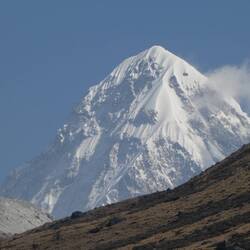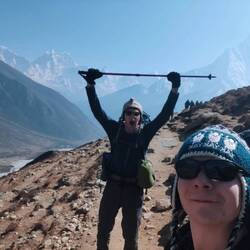- Show trip
- Add to bucket listRemove from bucket list
- Share
- Apr 1, 2024, 1:47pm
- ☀️ 17 °C
- Altitude: 3,731 m
 NepalEastern RegionGoliNaurTori̇̄phule Ḍā̃ḍā27°31’37” N 86°27’52” E
NepalEastern RegionGoliNaurTori̇̄phule Ḍā̃ḍā27°31’37” N 86°27’52” E
Day 12: Goli Gumba to Pikey Pk Base Camp
 April 1 in Nepal ⋅ ☀️ 17 °C
April 1 in Nepal ⋅ ☀️ 17 °C
Three whole kilometres of flat ground? Surely an April Fools' joke, we thought, but no. A gentle start from Goli Gumba eased us into the day's walking until we reached a dusty ascent, where some locals who were trying to kick a motorbike into gear (at 3000 m of all places) took an interest in us, and resulted in a bit of a bizarre selfie. What followed was a moderate climb through mossy, enchanting woods, which seemed to be dripping in colour: of red rhododendrons, blue blooms of flowers, rich in green shrubs, and bountiful in butterflies, especially given the altitude.
The journey was honestly a peaceful and enjoyable one, and it felt like no time at all until we'd pulled into a little teahouse for some chow mein lunch at 3400 m, with the growing Himalayan range staring back at us. The Nepalese who we came across at that teahouse were exceptionally hardy people, and we saw the old lady who we figured must've been in her eighties and a lama at the adjoining monastery, hauling a giant basket of firewood up the steps all while balancing the load with nothing more than her head (!) I don't know about your nan, but my nan struggles to walk in a straight line while carrying a cup of tea in her living room even (bless her), god knows how she'd fare with a ton of bricks on Kilimanjaro (sorry nan.)
Our final stretch of ascent was drawn out over the next few hours as we battled a shortness of breath due to the dwindling atmospheric oxygen, while passing little patches of ice on our way up to Pikey Peak base camp at an altitude of 3730 m. Here, we were surprised to see one thing, other trekkers?! Where the hell have they come from, and why are there suddenly so many? Realising that we won't be enjoying much solitude beyond this stage, I think we both have renewed cheer for how we'd chosen to do the previous sections, having enjoyed whole teahouses to ourselves literally every day. Still, with the chance to talk to some fluent English speakers, we met a South African couple who'd been travelling for over 2 years straight, survived death from a Laotian bus crash, and where the husband had been an understudy to Archbishop Desmond Tutu back when he worked. Pretty cool. And with that, we set down the shutters and prepared for a 4:30 am awakening to ambush Pikey Peak at dawn.
P.S. First day without signal so you won't see this as I write it!Read more










































































































Traveler Beautifully written as usual.
Traveler Think you've set nan a challenge.
Traveler Let's see her carry two cups of tea first
Traveler Nanny says she’s in training right now!! 😄